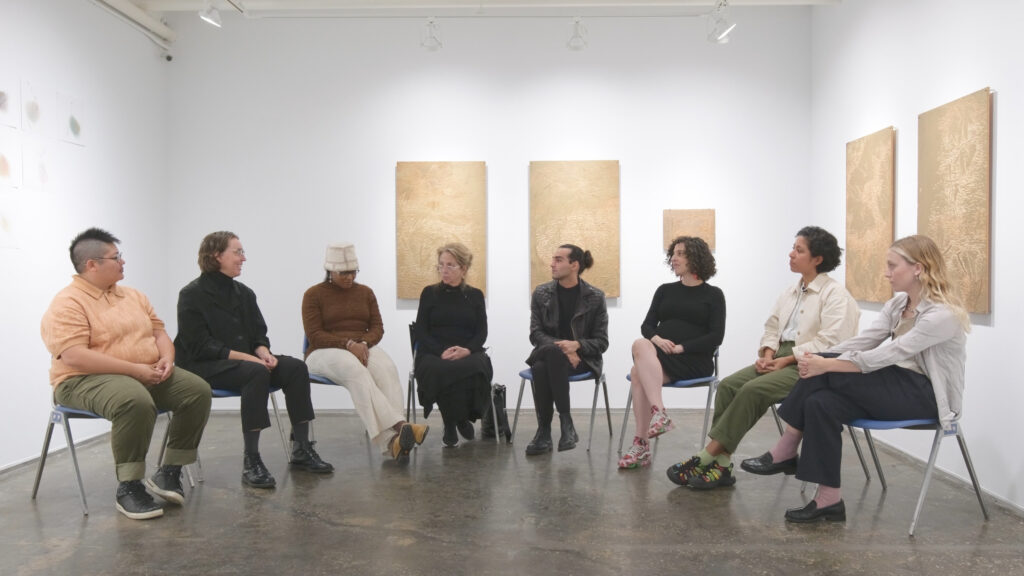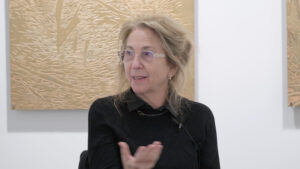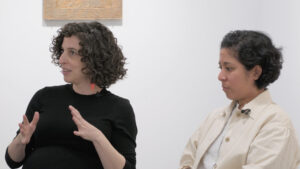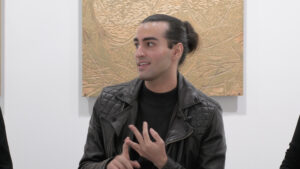A.I.R., New York
In conversation with Christian Camacho-Light, Susan Stainman, Joan Snitzer, Aya Rodriguez-Izumi
This interview excerpt is part of FCCW’s development of a co-leadership model, learn more here.

Susan:
So the way we’re structured—it’s kind of like concentric circles. The New York Members, or New York Artists, are all members of the cooperative and we’re also board members of the organization. So we make the decisions and help with the running of the gallery. And then even within that, there’s an executive committee of five members. The executive committee works most closely with the executive director and really is in the nitty-gritty of the running of the gallery. Then you have the Fellows that are part of the community for a year. We have National Members, or National Artists, across the nation. The New York Members are all generally in New York because we need to be close to the gallery. We max out at 20 members.
Christian:
20 was the original number of founding members in 1972.
Joan:
And that was based on one member exhibition a month in one shared space. And so the members exhibited every other year. That was 10 months. The 11th month was for a curated group show and then in August the gallery was closed. So that’s why that number.
Susan:
So I should say that this space that we’re in is where the New York Members show. So we are both artists and also board members, and we have these dual roles. We have three galleries in our current space and the second and third galleries will either be National Artists or Fellows or outside artists or open calls. We run just about 25 shows a year.
National Members are from the rest of the country but are less involved. There is a group show in all three galleries at one point during the year with the National Members. We have Alum Members who have previously been Fellowship, National, or New York Members. And then Adjunct, which is somewhere in between.
Christian:
An Adjunct Member is a former New York Member who has been a member of the cooperative for at least seven years and wants to take a step back and not be so involved in volunteer work on committees, but still wants to contribute to the gallery in other ways. Right now, we have four Adjunct Members and all these different concentric circles that Susan’s talking about all have their own kind of historical contexts. The National Artists Program is a program that was started in 1981. What we call the New York Membership, the members of the cooperative, is a structure that goes back to 1972. The Alum program is more recent, but at least a decade old. And so there are different…
Joan:
And the Fellowship Program.
Christian:
The Fellowship Program was established in 1993, originally as a means of bringing emerging artists for a year into the cooperative structure and the feminist ways of working of the organization.
Sarah:
The Fellows are New York based too?
Christian:
Yes, exactly.
Joan:
That’s part of the requirement. You have to be here and participate, and never have had a solo show in New York.
Christian:
So since 1993, the Fellowship Program has awarded over 120 women and non-binary artists with their first solo show in New York City. And I guess what you see in the formation of these concentric circles are different ways of trying to think about community and connection. You see this very locally centered organization that starts to try to think nationally with the National Artists Program. And this program comes into being in ’81 in the context of the eighties, when the landscape for arts organizations in general, but especially for a feminist arts organization, starts to become really different.
Sarah:
Maybe we could go back. Circles are helpful as an organizing strategy and what their impetus was.
Christian:
Yeah, maybe historically we start in ’72?
Sarah:
We like the depth. Don’t worry about going back.
Christian:
So in 1972—I mean, at the time, women artists were not being shown in museums. They were not being shown in commercial spaces. And Barbara Zucker and Susan Williams—it was the two of them at first—decided that they wanted to start a co-op gallery, which there was a long history of in New York. But a women’s co-op gallery, a space where—kind of seeing the lay of the land and realizing that the mainstream venues weren’t going to show their work—they would find their own place and show their own work.
So Barbara Zucker and Susan Williams got together and invited four other women: there was Mary Grigoriadis, Dotty Attie, Nancy Spero, Maude Boltz. Then, using a slide registry that Lucy Lippard and the Ad Hoc Women Artists’ Committee were putting together of slides of women’s work, they did many, many studio visits with different artists, some of whom they were familiar with, many of whom they weren’t.
They ultimately selected 14 who would join them in being the 20 founding members of the cooperative. Together, they found a space on Wooster Street. They re-did the entire space themselves. They set up all the bookkeeping themselves. They sat the gallery themselves. So the first opening at A.I.R. was September 16, 1972. We were just celebrating our 50th anniversary this last year. Now we’re 51.
And among those early members are names that are really recognizable today, but weren’t at the time: Judith Bernstein, Howardena Pindell, Agnes Denes, Kazuko Miyamoto.
They really launched their careers through the support of A.I.R. There was a lot of really great press in those first couple years, but there were also certain critics who seemed a little confused about there not being any recognizable style or way of working at the gallery. Kind of this refrain of like, “Oh, the work seems really good, the quality is there, but I have no sense of what women artists are making. What are women making?”
Sarah:
As a whole group.
Christian:
As a whole group. But of course, that was the point—that polyvocality, that multiplicity was really central to A.I.R. in 1972 and continues to be today. I mean, if you walk through the galleries any particular month here at A.I.R., you’re going to see artists who are interested in many different things, working in many different ways. The members of the cooperative themselves also share this multiplicity. But the connecting device is the shared labor in supporting this organization, supporting this vessel that is A.I.R. So that’s ’72.
[…]
Sarah:
I think we were curious, just among membership, are you trying to expand certain demographics? I was thinking about us and we’re always like, “Who is our audience versus who are we, and how much difference should there be?” Are we always trying to be shifting it towards a new group of people? Are you concerned about keeping legacy members or are you more concerned about who’s in this membership collective?
Aya:
I think there’s a real focus to expand that. Historically, the feminist landscape has been very white and is not actually reflective of the actual community. And because there was such a focus on that, a lot of the membership at A.I.R. was also historically white, and now I think it’s really a focus to diversify that because it’s more reflective of what the community in general is. And in some places we do it really well, in some places we’re still working on it. But there is an effort within the organization to try and be reflective of what that larger landscape looks like.
Christian:
And this has been something that the organization has been grappling with for a long time. It was 1980, I believe, when Ana Mendieta, who was then a member, Kazuko, and Zarina, who was not a member but was around, organized Dialectics of Isolation: An Exhibition of Third World Women Artists of the United States. Which was at A.I.R. but was also in many ways about A.I.R. It was about the feminist art community and its inability to kind of take up race as an important critical axis of feminist work and action. And to the conversations that are happening today that Aya was pointing to, A.I.R. comes out of that early 1970s second-wave feminist moment. And there are those beautiful things about that moment, and there are those not-so-beautiful things about that moment.
And like we’ve been talking about before, there is this question of “What does our mission mean in 2023?” How do we meet the needs of our communities? Both—again, concentric circles—close and far from A.I.R.’s center? And thinking about an intersectional feminist politics—I’ll speak for myself because the A.I.R. authorial voice, as we were pointing to, is many different people with many different backgrounds and ideas. But I think for me, feminist politics in 2023 has to be intersectional. It has to be thinking critically about all these ways in which we’re impacted by the world and faced with different structures of oppression and privileges. It’s not enough just to be focused on gender as one axis, because we’re not singular-axis beings.
Aya:
Well, I feel like that’s something that’s just reflective of the art world in general—the people of color who are in it have to be the superstars of it. So if that’s 1%, then where’s the other 99%? And to open it up, so not every person of color that’s part of A.I.R. has to be a superstar, we have to make room for people at different points of their careers.
Sarah:
It gets back to that equity question.
Aya:
Exactly. What is it about—what are the qualifications for being a member here? Is it your career history, is it gender, is it race? Is it just where you physically are? And what I’ve been seeing, more recently, is really kind of mixing up all of those things. And I think Christian used a great word for it, thinking of it really more intersectionally, and realizing that the kind of idea of feminism is just one point of contact with A.I.R. And there are multiple pillars that are lifting up this whole community.
Christian:
We talk a lot at A.I.R. about this idea of feminisms, this plural. Both because it feels more natural to A.I.R.’s own structure, but also it feels more reflective of the fact that feminism, both its history and its contemporary theory and praxis, doesn’t mean the same thing to everybody. It’s taken in many different ways, it’s actualized in many different ways.
Joan:
When A.I.R. started and these 20 women got together, although people did look at the work, it was a novelty. They were the poor, sort of stepchildren of the art world that nobody wanted and nobody would look at. And they made a space to be seen. The art world, I use that liberally, was a very small number of contemporary galleries. And so once A.I.R. opened its doors, whether it was by guilt or curiosity or actual commitment, everybody did come through A.I.R. It was on the list of the galleries to be seen, and it was always written about. But its status was still as an isolated add-on, it wasn’t really accepted as mainstream. They thought it was cute or fun or, “What are those girls at A.I.R. doing?”
I think with 50 years of experience, 50 years of going forward in survival, A.I.R.’s mission now has become its own superstar. And there’s a new concept that women or non-binary people can also be leaders—that was not happening then. Women weren’t leaders, we were just charity. Now A.I.R. can lead, it can make decisions and forward decisions. That’s a new kind of responsibility and a new level to consider—and why some of these discussions have been so hard.
We no longer are the nice girls down the block, we have a legacy. And I think in general, in the culture, people are beginning to see, yes, women can lead organizations and corporations and be university presidents and country presidents—if that’s anything. But A.I.R. also has to take and own that moving forward. And it’s great and it’s a more difficult thing to consider.


